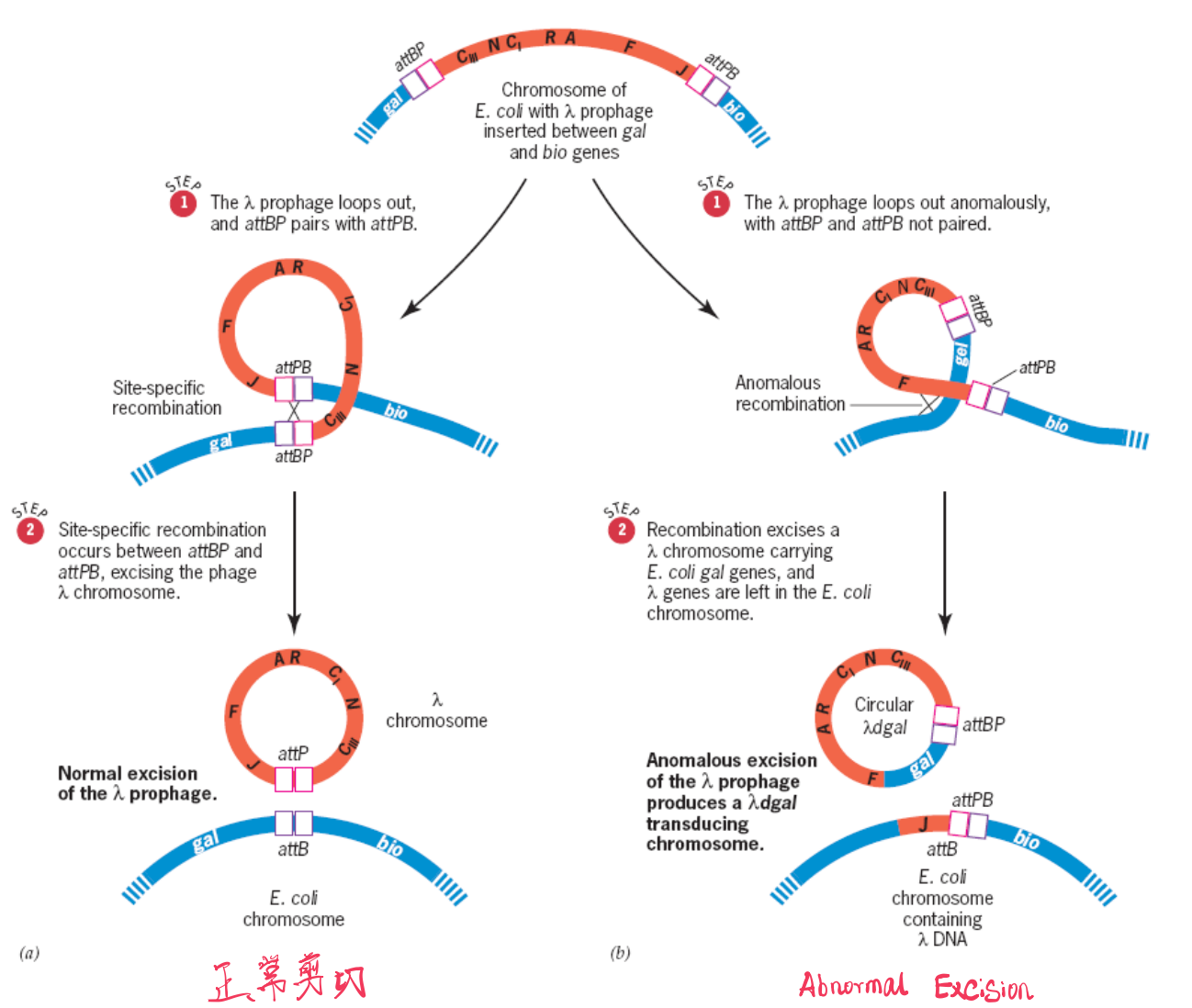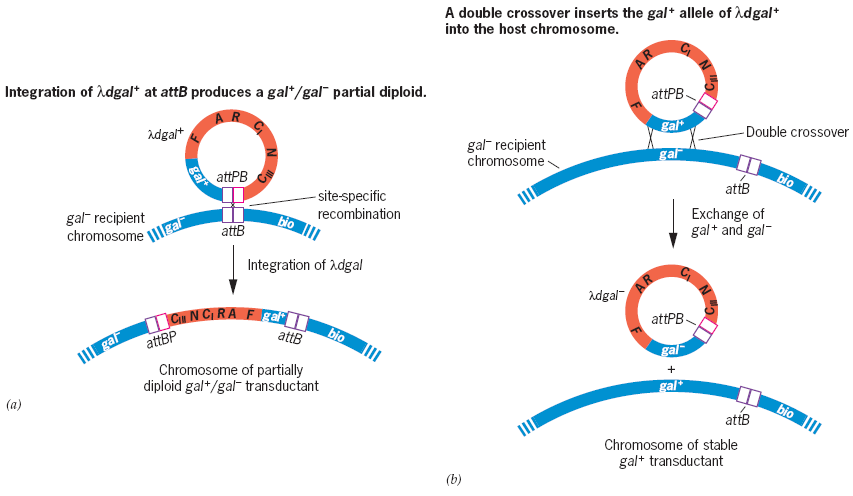L08 Genetics of Bacteria and Bacteriophages
一、The Bacteria And Virus
The Similarities of Bacteria and Viruses
- Small size
- Short generation time
- Selective media (e.g. antibiotics)
- Simple structures and physiology
- Usually haploid – what is the advantage?
- Genetic variability
- Complete genome sequences
Virus
- Non‐living particles
- Medically important – cause many diseases
- Nucleic acid genomes
- Both prokaryotic and eukaryotic cells are infected
- Rely on living cells to replicate
- Size of genome quite variable
- Circular or linear
1. Bacteriophage T4 (Phage T4)
Structure And Characristic
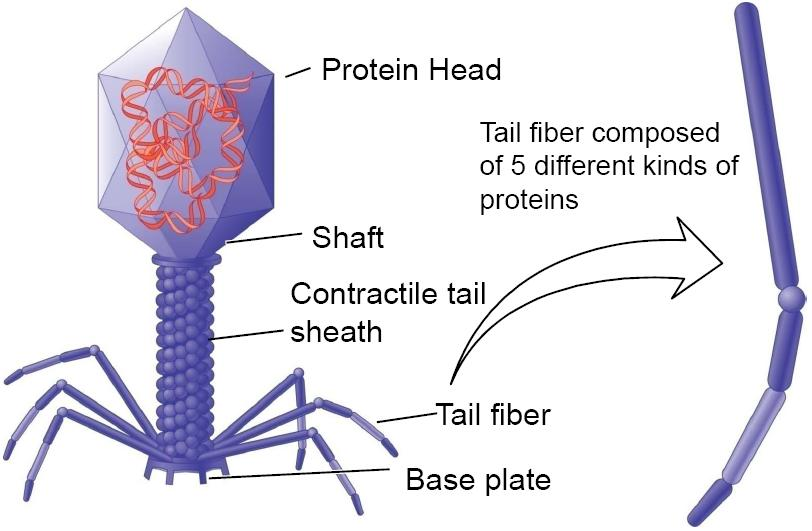
- Double‐stranded DNA genome
- Virulent phage: Use the metabolic machinery of the host cell to produce progeny virus and kill the host in the process
- Lytic phage
Life Cycle
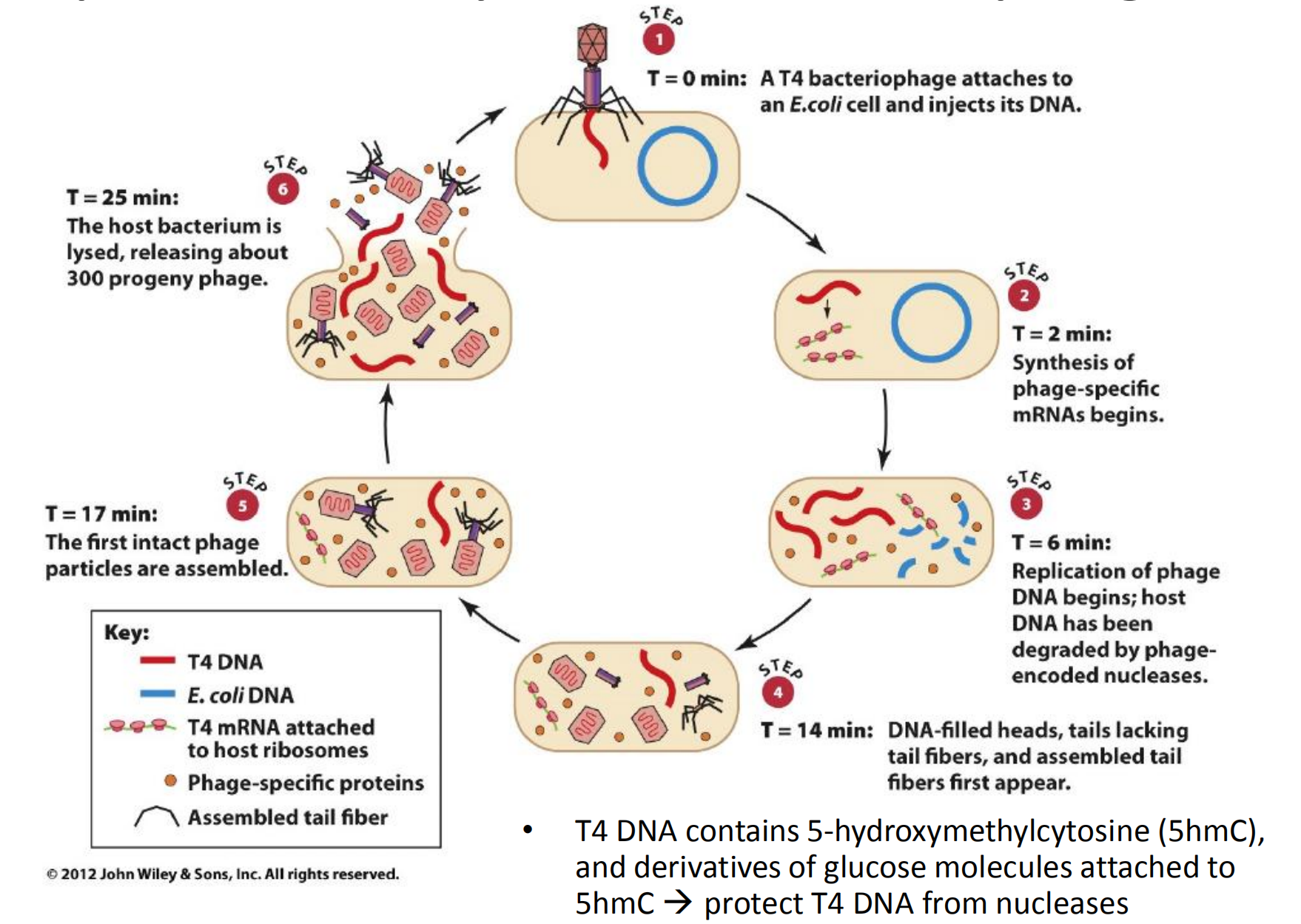
Genetics Mapping in Phage T4
Use a type of genetic mapping known as intragenic (基因内的) or fine structure mapping
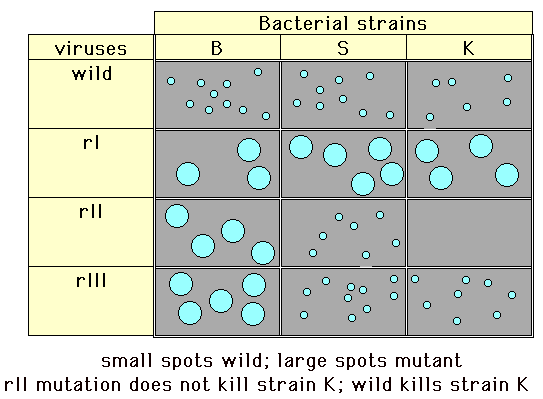
To test if the mutations causing differences in plaque morphology are in the same gene or different genes(检测引起斑块形态差异的突变是否来自同一基因或不同基因), a complementation test can be performed
- Use two mutant strains to infect the same cell
- If no wild‐type plaques are obtained it indicates that the mutations are in the same gene – noncomplementation
- If wild‐type plaques are obtained it indicates that the mutations from each strain are in different genes –complementation
(1) Noncomplementation
The phage mutations are in the same gene
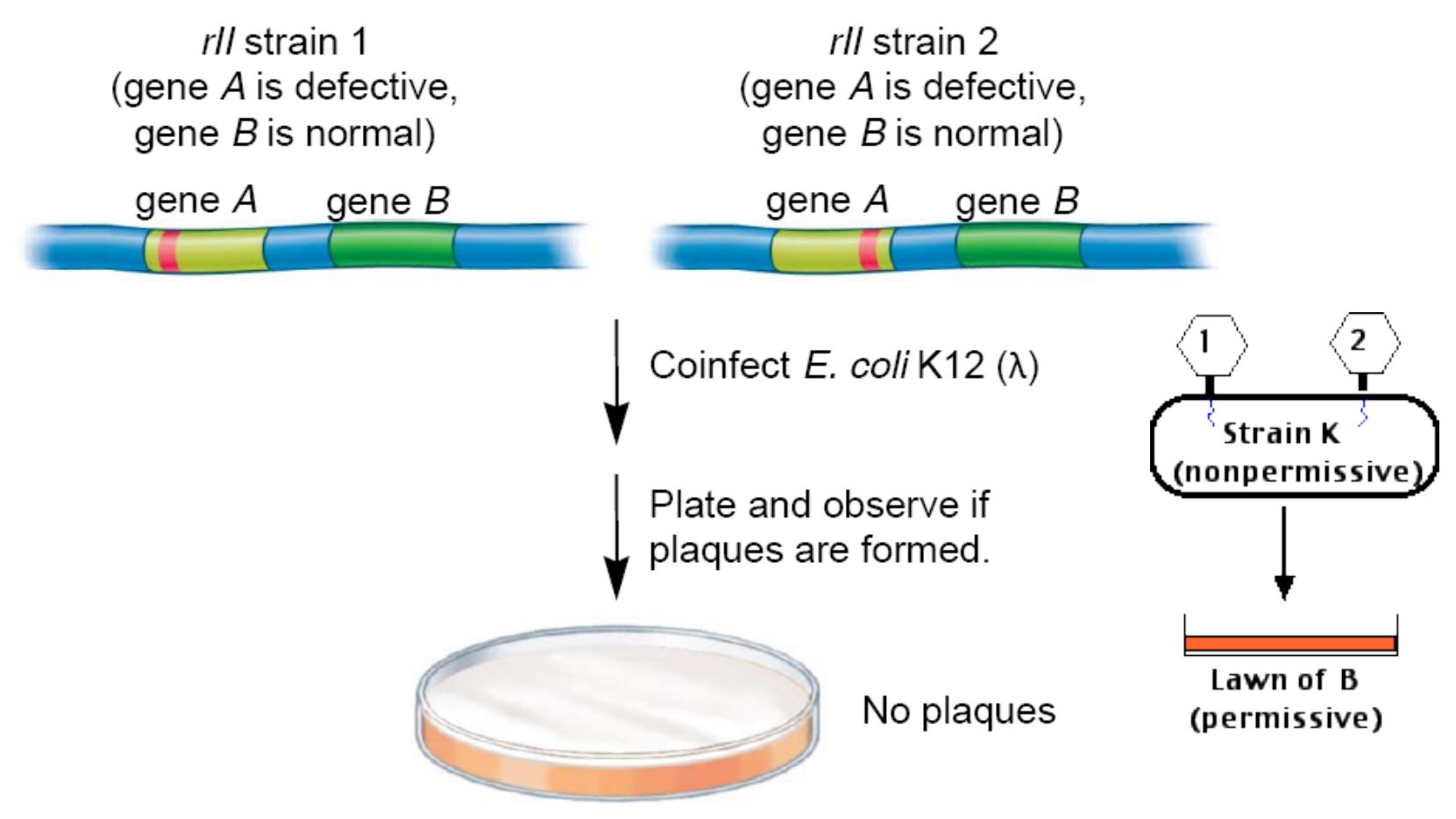
No complementation occurs, because the coinfected cell is unable to make the normal product of gene A.
The coinfected cell will not produce viral particles, thus no bacterial cell lysis and no plaque formation.
(2) Complementation
The phage mutations are in different gene
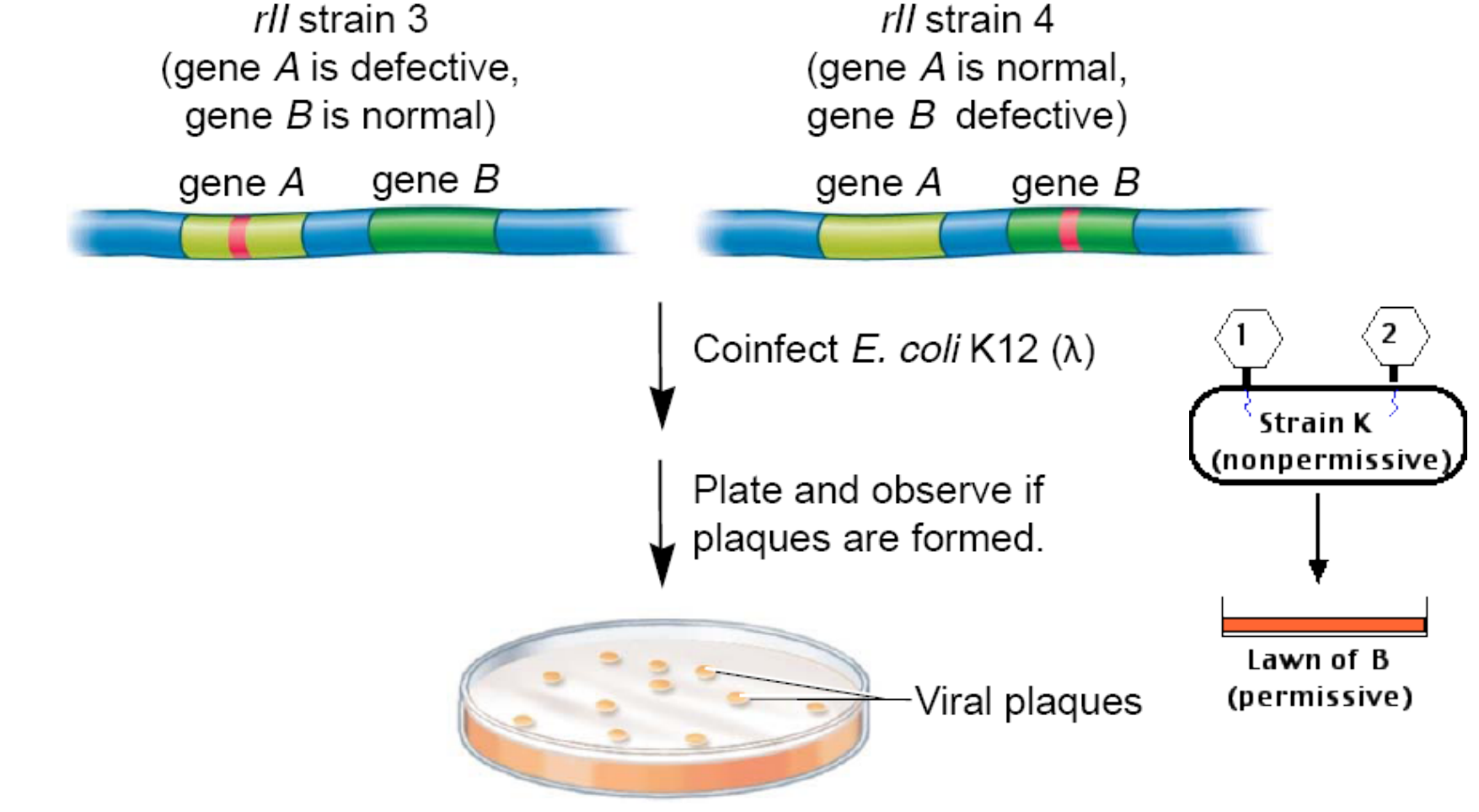
Complementation occurs, because the coinfected cell is able to make normal products of gene A and gene B. The coinfected bacterial cell will produce viral particles that lyse the cell, resulting in the appearance of clear plaques.
(3) The Recombination Test
Seymour Benzer decided to find out
Could wild-type virus be formed by recombination between mutations within the same gene? (是否可以通过同一基因内突变之间的重组形成野生型)
The Recombination
- the recombination frequency between different genes is low (on the order of 10-2 ).
- One would expect that recombination frequencies between mutations in a single gene would be far lower (10-4 or less).

He conducted a detailed type of genetic mapping known as intragenic (基因外的) or fine structure mapping
- The difference between intragenic and intergenic mapping is:
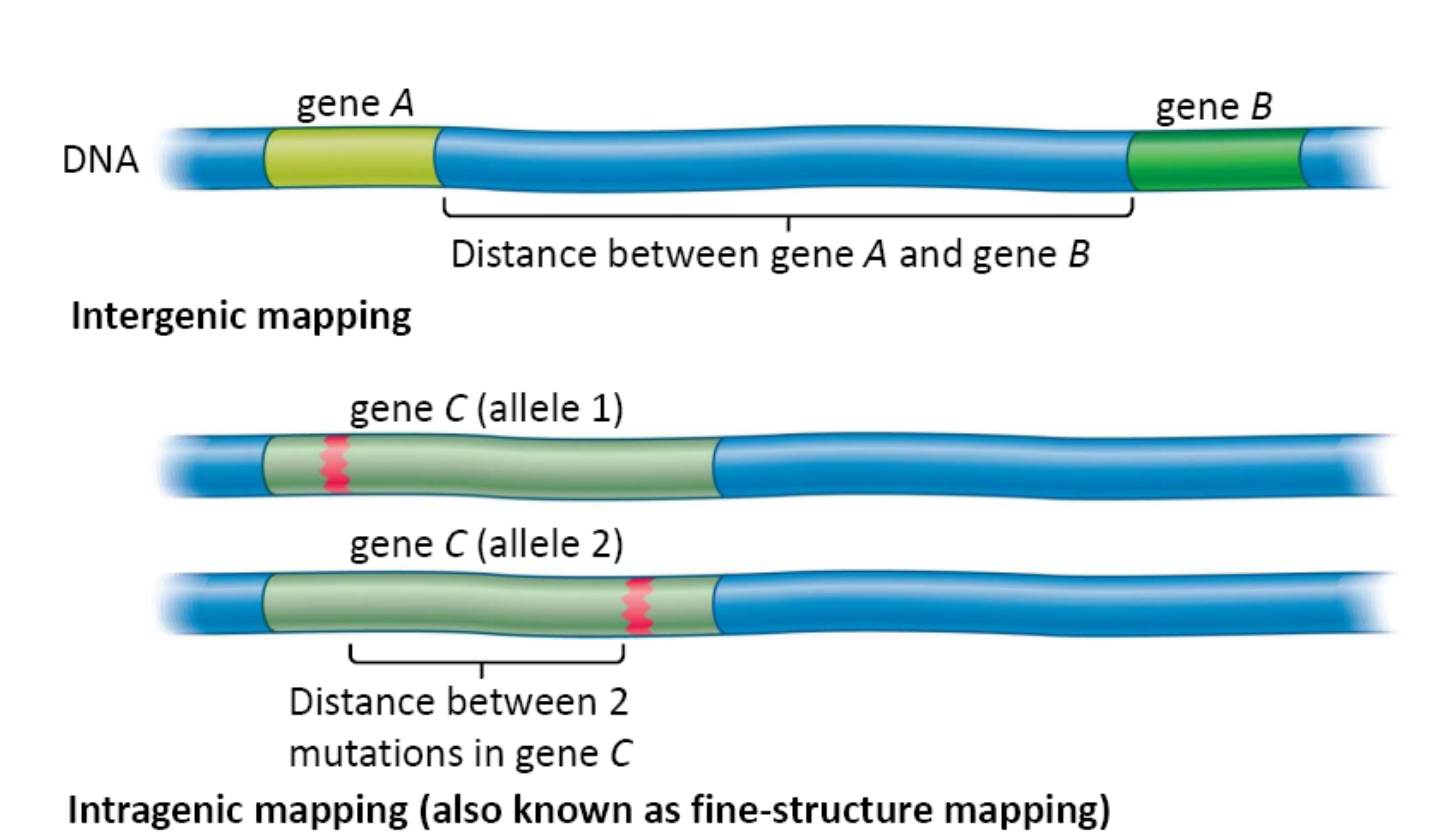
Recombination Test
Recombination Frequency = 2 × number of wild-type plaques (strain K plaques) ÷ total number of plaques (on strain B).

- Benzer had tested 2,400 different mutations in the rII gene. The recombination frequency between some pairs of these was as low as 0.02%.
- The T4 genome has 160,000 base pairs of DNA extending over ~l,600 centimorgans (cM).
- So 1 cM $\cong$ 100 base pairs
- So 0.02 cM represents a pair of adjacent nucleotides.
From these data, Benzer concluded that the smallest unit of mutation and the smallest unit of recombination was a single base pair of DNA.
In other words,
these mutations represent a change in a single base pair — we call these point mutations.
Recombination between two molecules of DNA can occur at any pair of nucleotides.
2. Bacteriophage Lambda (Phage $\lambda$)
Structure And Characteristic
Double‐stranded DNA genome
Temperate viruses: 2 phases
- Lytic phase: cause lysis of cells;
- Lysogenic phase: integrate into host chromosome as prophage ($\lambda$ chromosome) . Do not lyse cell. Can leave genome and enter lytic phase.
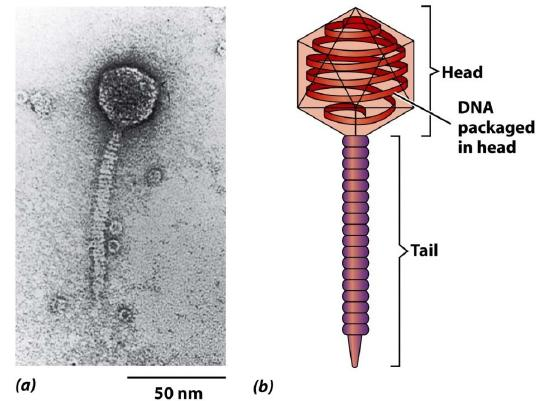
Life Cycle
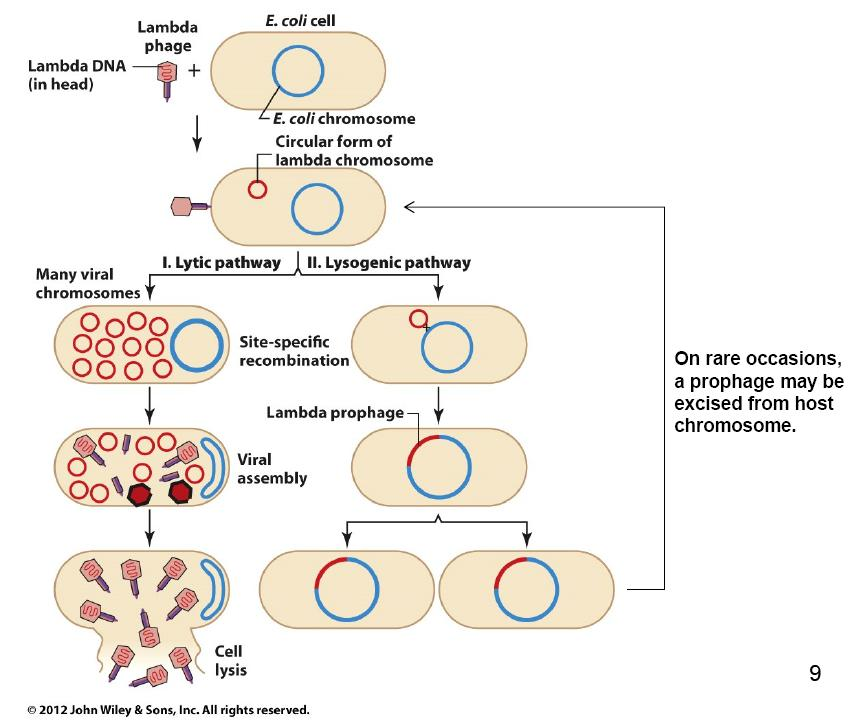
$\lambda$ DNA Insert E.coli Bacteria DNA
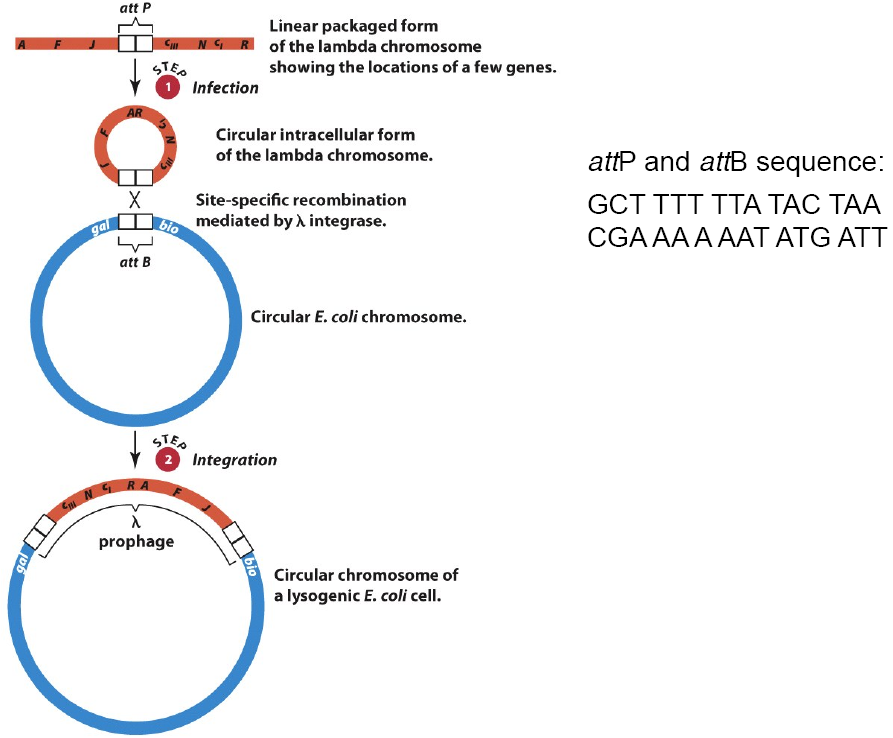
3. Plaque Formation
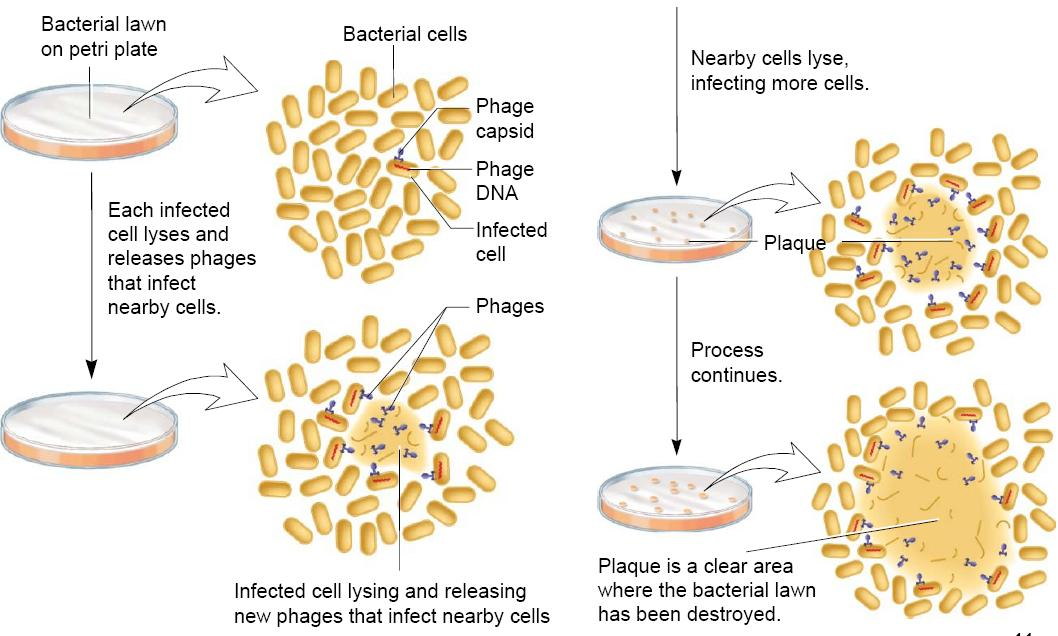
4. Phage T2 Genetics Mapping
h Mutant
When plated on a lawn containing both E. coli B and E. coli B/2, the mutant (h) viruses can lyze both strains of E. coli, producing clear plaques, while
the wild-type ($h^{+}$) viruses can only lyze E. coli B producing turbid (浑浊的) plaques.
r Mutant
The mutation occurs in a gene designated r (for “rapid lysis”). It reveals itself by the extra-large plaques that it forms.
The wild-type gene, producing a normal time of lysis, is designated $r^{+}$. It forms normal-size plaques.
Mapping
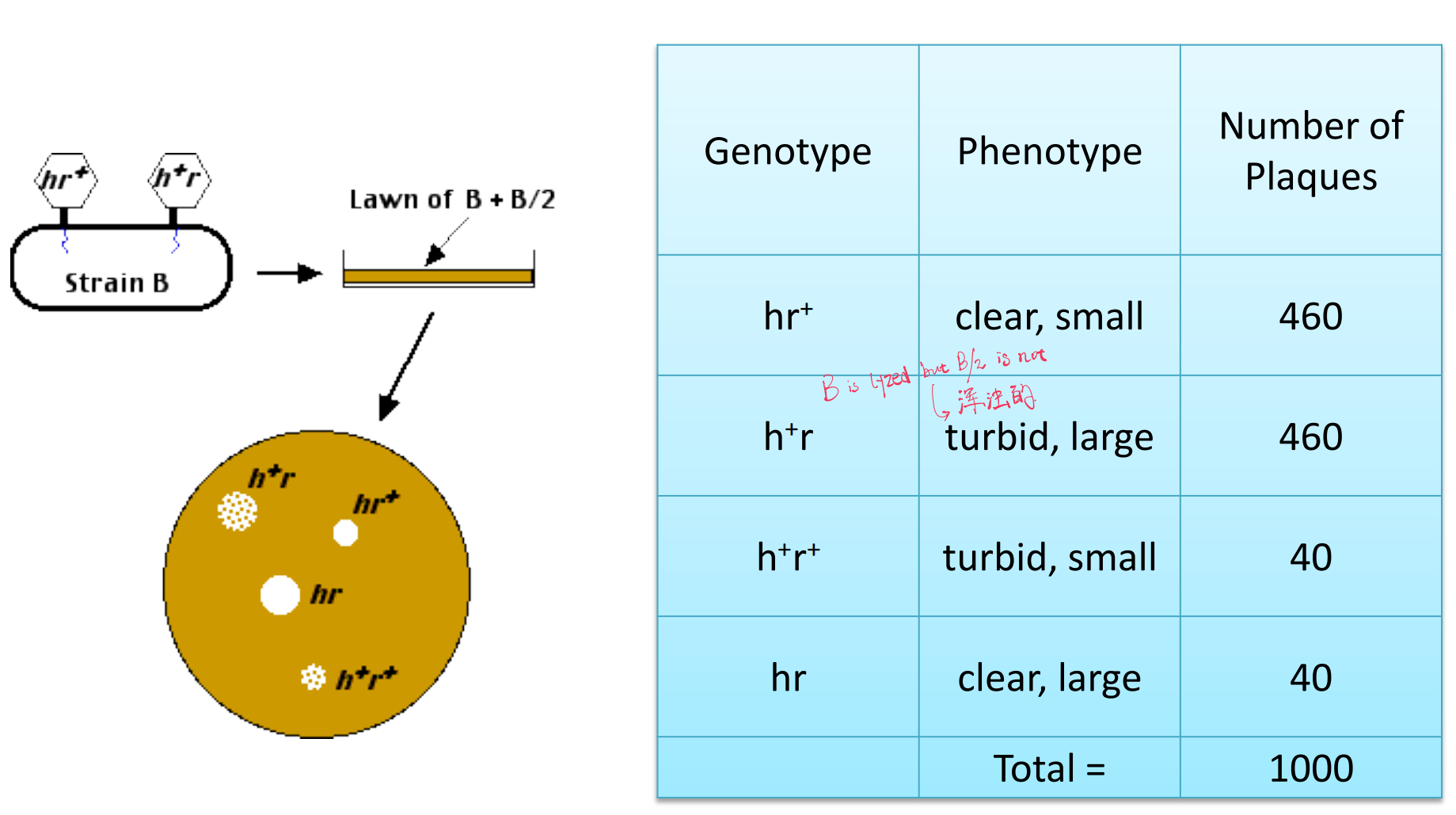
Gene And Chromosome
Genes like beads on a chromosome
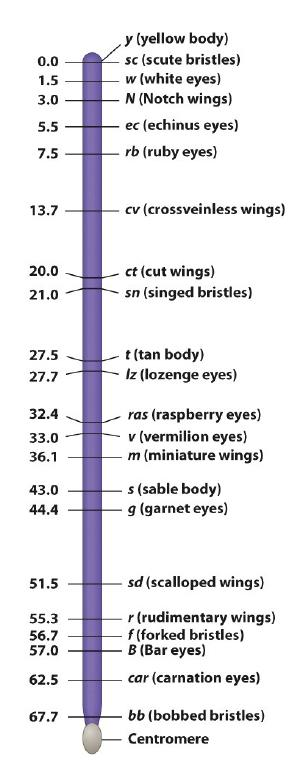
Bacteria
1. Characterics
- Living organisms
- A single main chromosome within a few thousand genes
- Plasmids and episomes (Extrachromosomal element)
- Plasmids: Circular (or infrequently linear) piece of DNA
- F Factor (Fertility Factor)
- R Plasmids (Resistance Plasmids)
- Col Plasmids (synthesize compounds that kill sensitive cells)
- Episomes: Circular piece of DNA that can exist as an extrachromosomal element or can integrate into chromosome of host
2. Genetic Transfer in Bacteria
Transfer of genetic material from one bacterium to another can occur in three ways:
- Conjugation (接合): Involves direct transfer from one cell to another
- Transduction (转导): Viruses transfer DNA between bacteria cells
- Transduction mediated by phage.
- Transformation (转化):
- Involves uptake of DNA from the environment
- Gene transfer in bacteria is unidirectional—from donor cells to recipient cells.
This is kind of Parasexual processes (类有性生殖)
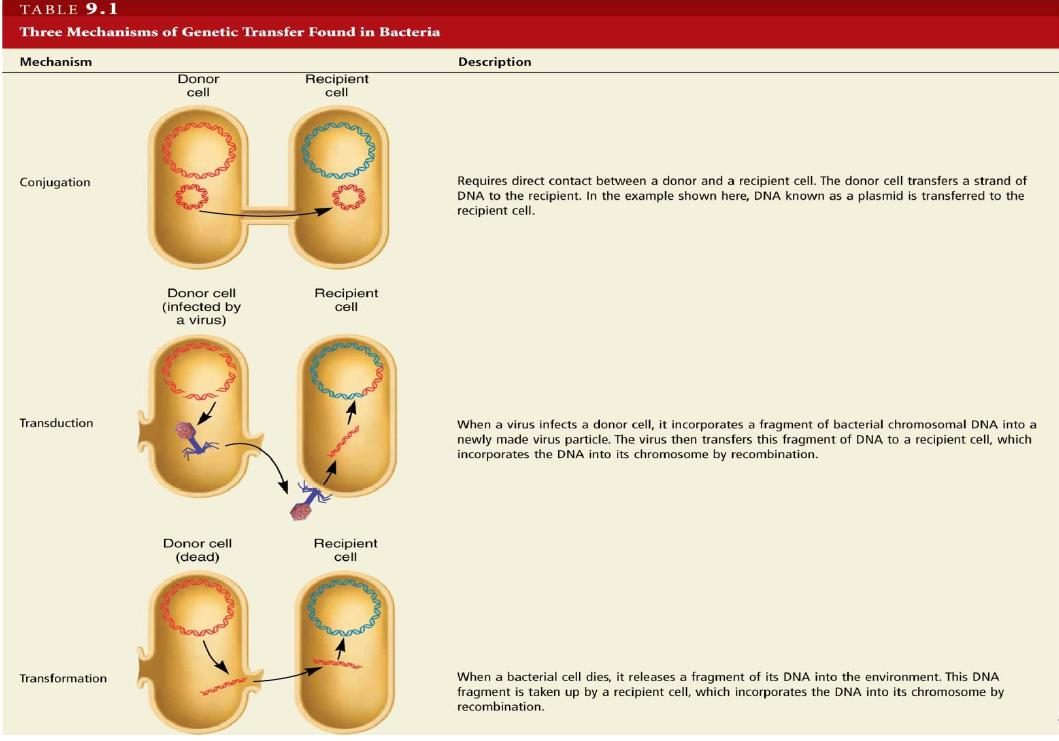
The Differece Between The Three Kinds of Parasexual Process
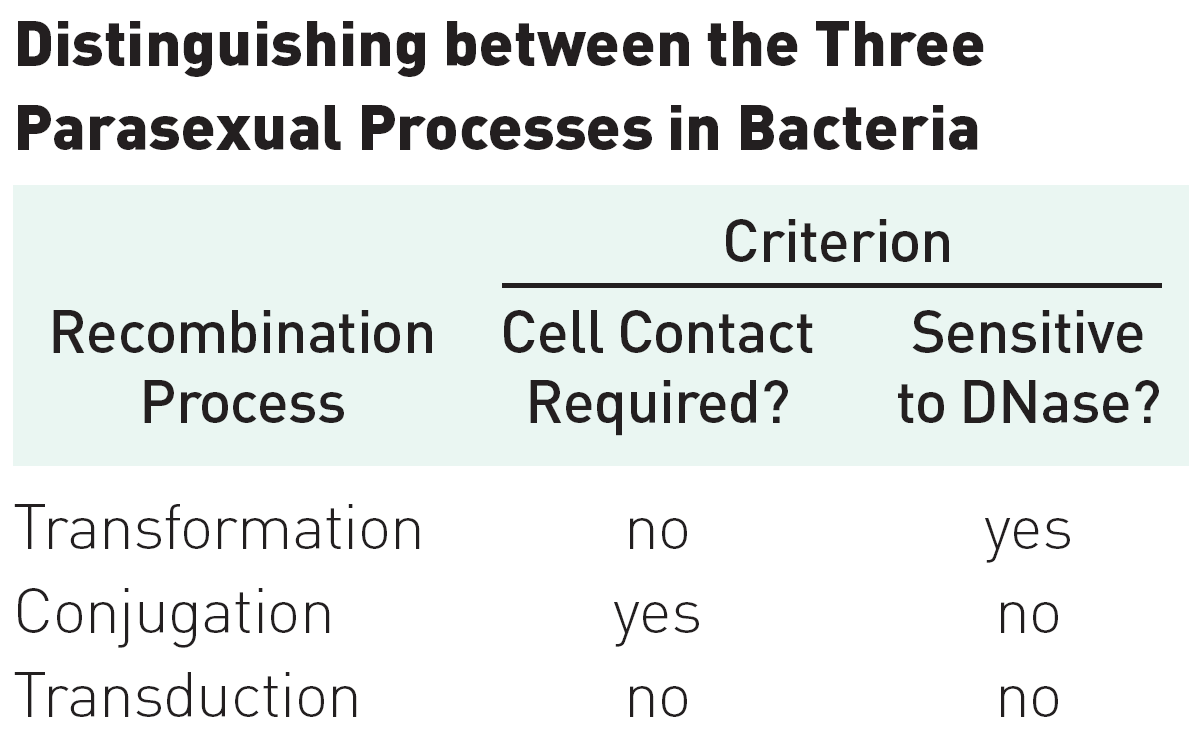
Cell Contact means Direct cell contect
Recombinations in bacteria
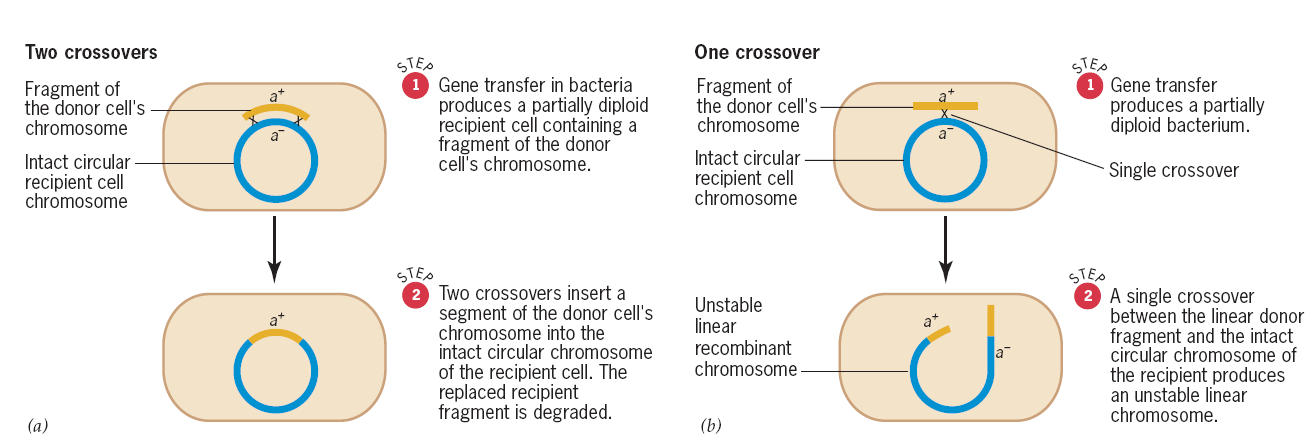
The one crossover is unstable, because originally the bacteria chromosome exists in circular form, but after the one crossover the circular chromosome become linear.
3. Transformation
Transformation is the process that a bacterium take up of free extracellular DNA.
1. Natural transformation: DNA uptake occurs without outside help
2. Artificial transformation: DNA uptake occurs with the help of special techniques (热激,电激)

Discovery of Transformation
Discovered by Frederick Griffith in 1928 while working with strains of Streptococcus pneumoniae (pneumococcus)

- Type S: Encapsulated, virulent, large and smooth colonies in blood agar medium
- Type R: Mutated nonencapsulated, avirulent, small and rough colonies in blood agar medium
- Type II & III: Produce different types of antigens
Different type = Different polysaccharide in the capsule
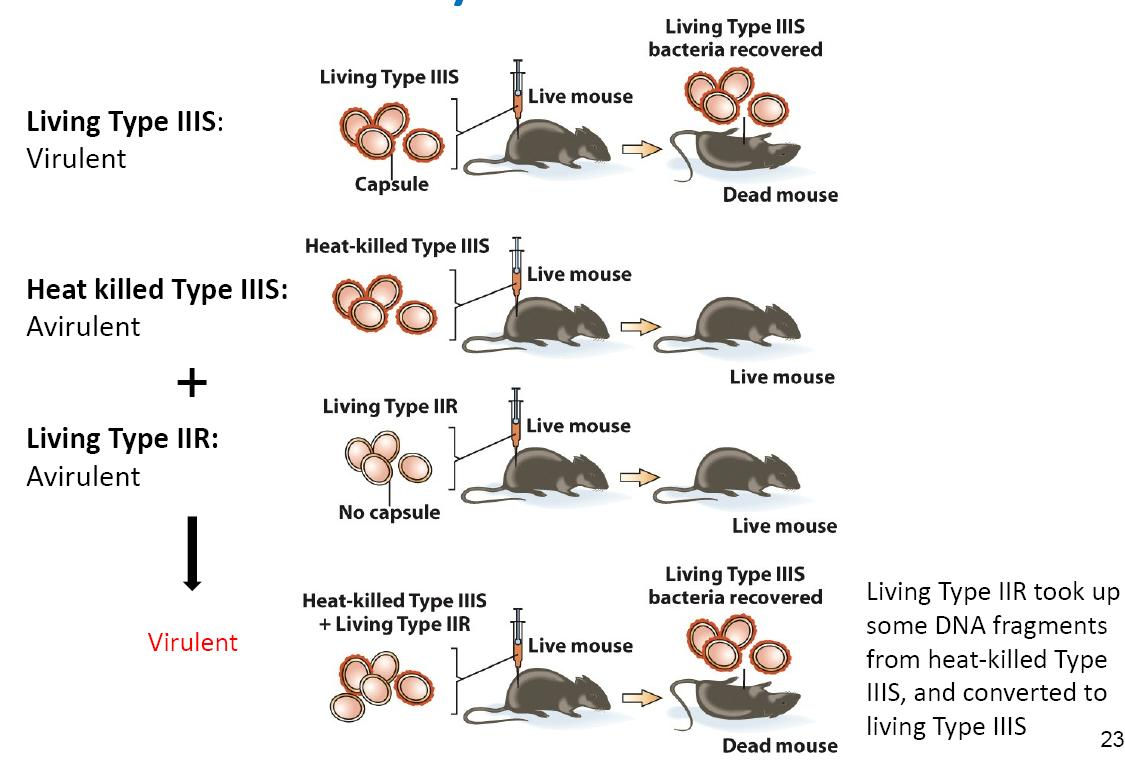
Natural Transformation
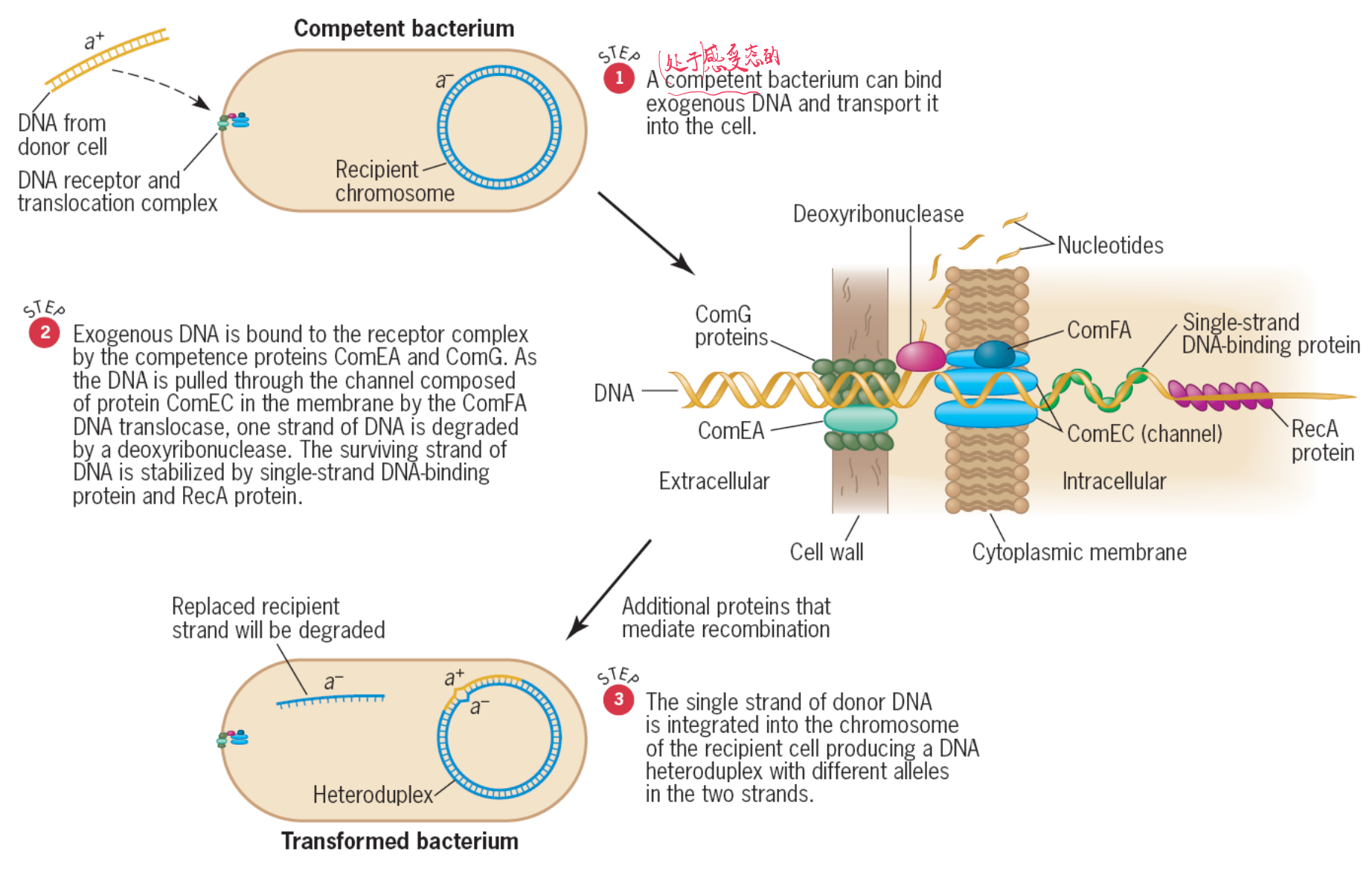
A competent (处于感受态的) bacterium can bind exogenous DNA and transport it into the cell.
Exogenous DNA is bound to the receptor complex by the competence proteins ComEA and ComG. As the DNA is pulled through the channel composed of protein ComEC in the membrane by the ComFA DNA translocase, one strand of DNA is degraded by a deoxyribonuclease. The surviving strand of DNA is stabilized by single-strand DNA-binding protein and RecA protein.
The single strand of donor DNA is integrated into the chromosome of the recipient cell producing a DNA heteroduplex with different alleles in the two strands.
Artificial Transformation
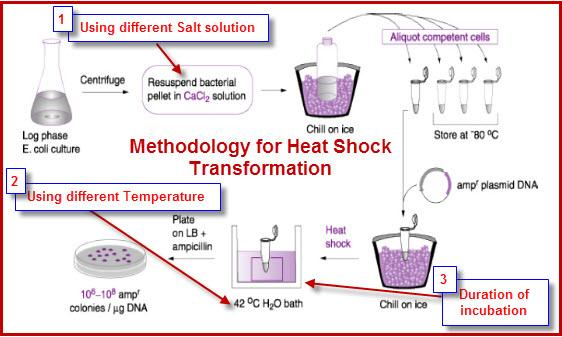
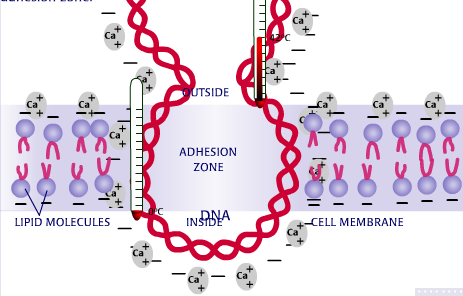
4. Conjugation
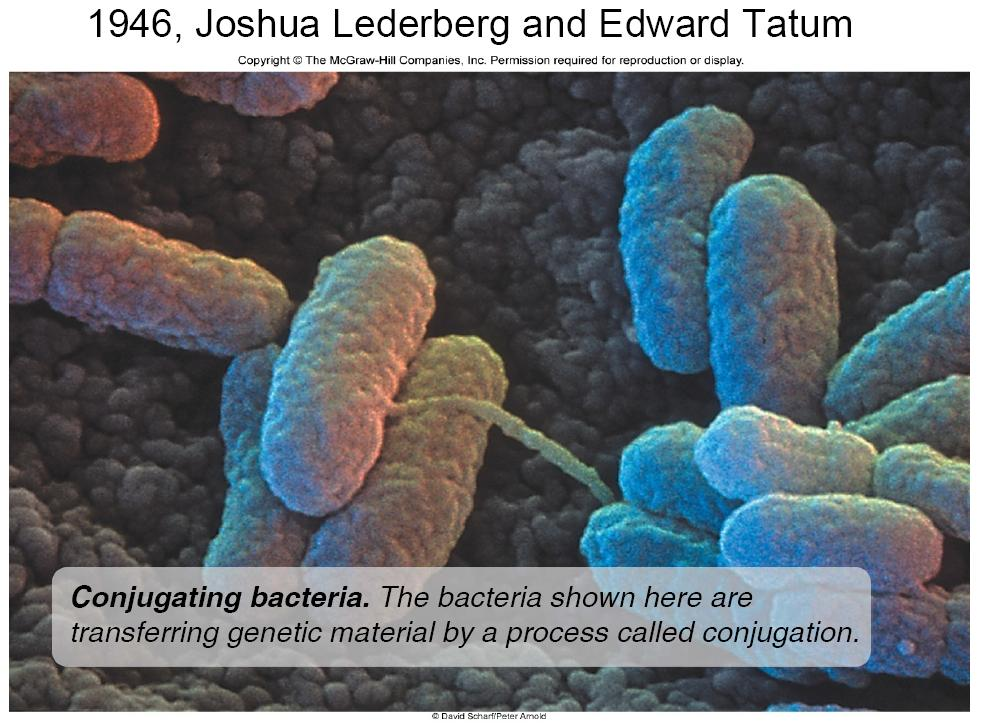
Genetic transfer in bacteria was discovered in 1946 by Joshua Lederberg and Edward Tatum
They were studying strains of Escherichia coli that had different nutritional growth requirements
- Auxotrophs (营养缺陷型) cannot synthesize a needed nutrient
- Prototrophs (原养型) make all their nutrients from basic components (Carbon resource or the Nitrogen resource)
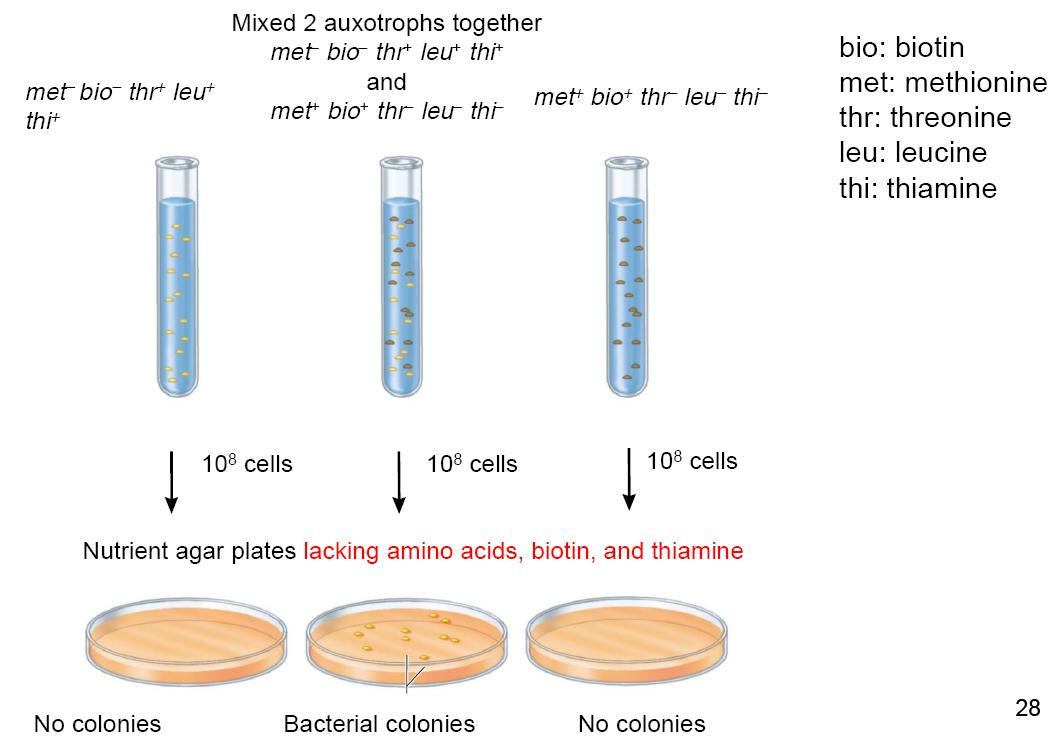
证明两种E.coli之间发生了遗传物质交换
This conjugation needs direct contact:
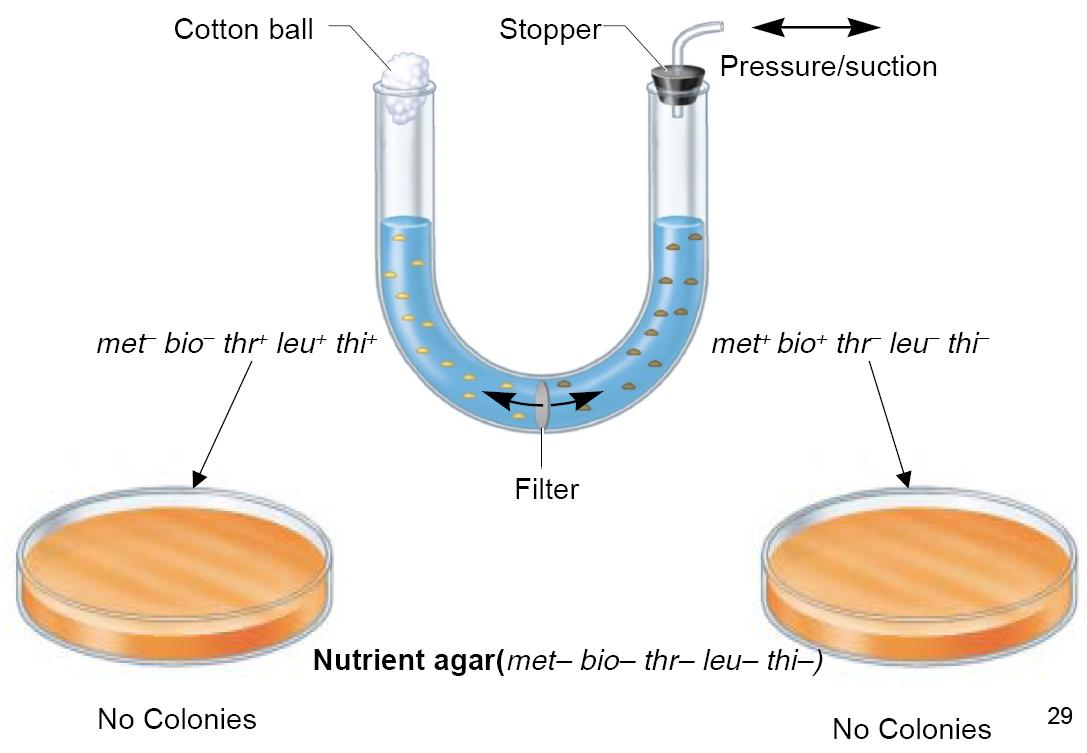
- Conjugation refers to the transfer of DNA from one bacterium to another following direct cell-to cell contact
Many, but not all, species of bacteria can conjugate
Only certain strains of a bacterium can act as donor cells
- Contain a small circular piece of DNA termed the F factor (for Fertility factor)
• Strains containing the F factor are designated as F+
• Those lacking it are $F^{-}$
F (Fertility) Factor
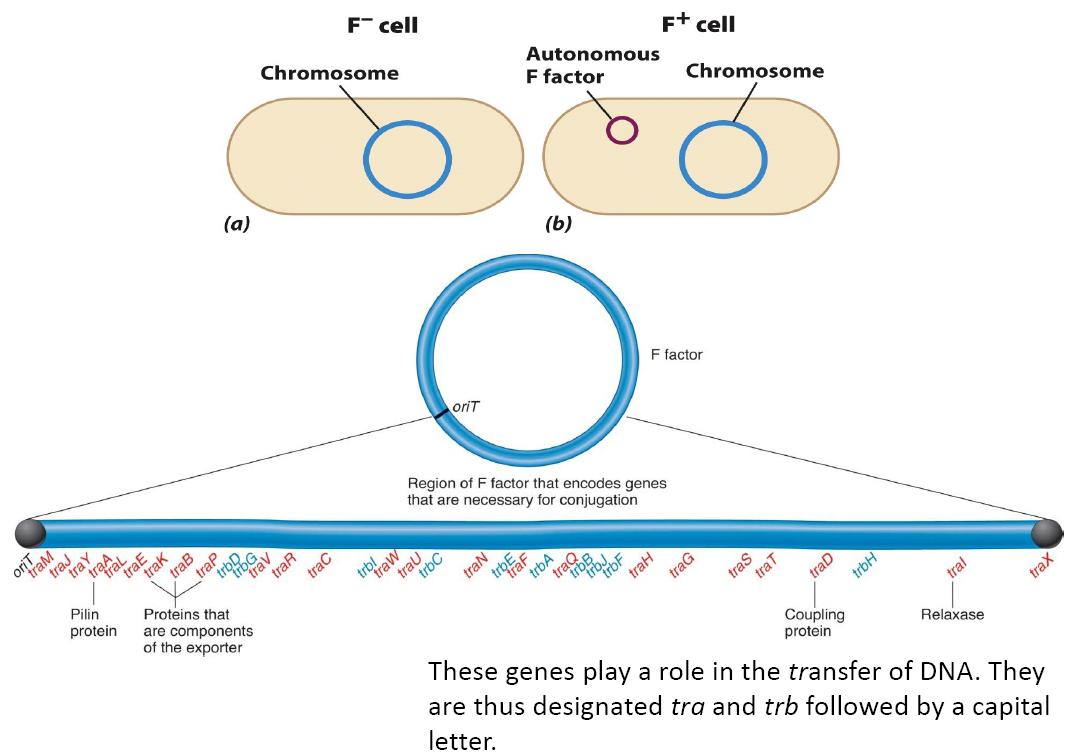
The Conjugation Process
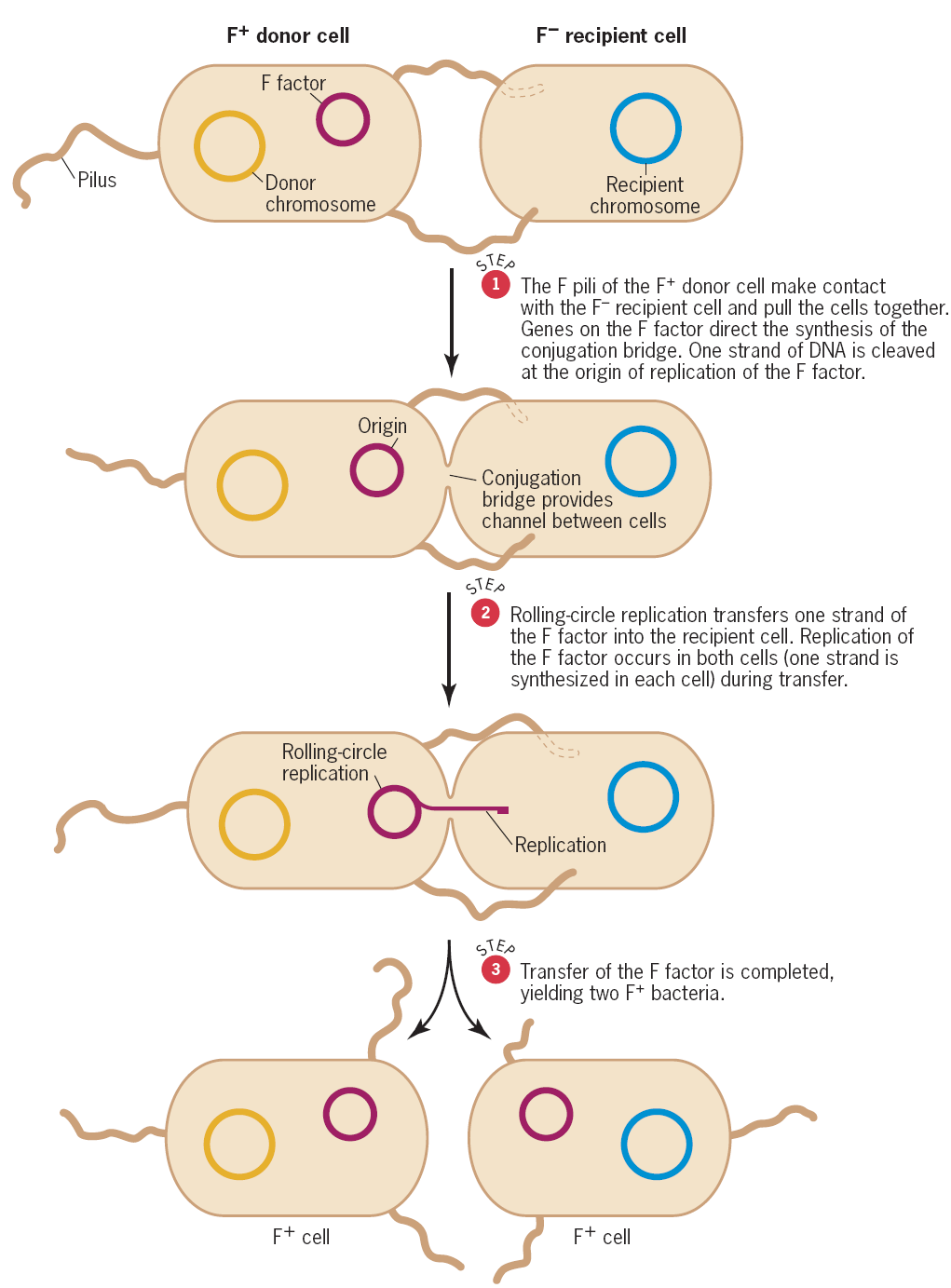
Rolling-Circle Replication
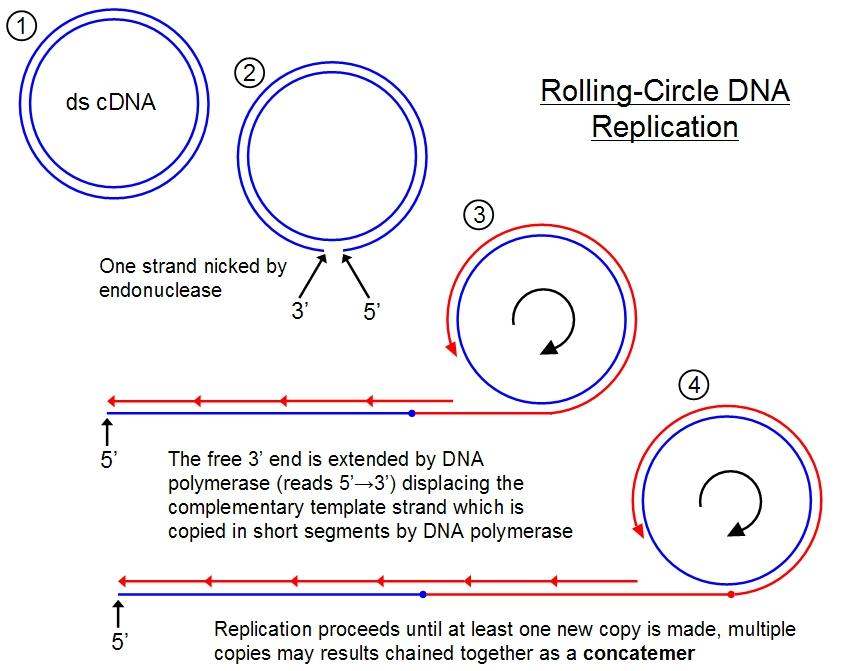
Primer: 在反应中可以添加3’–OH的物质
Integration of F Factor to form Hfr cell
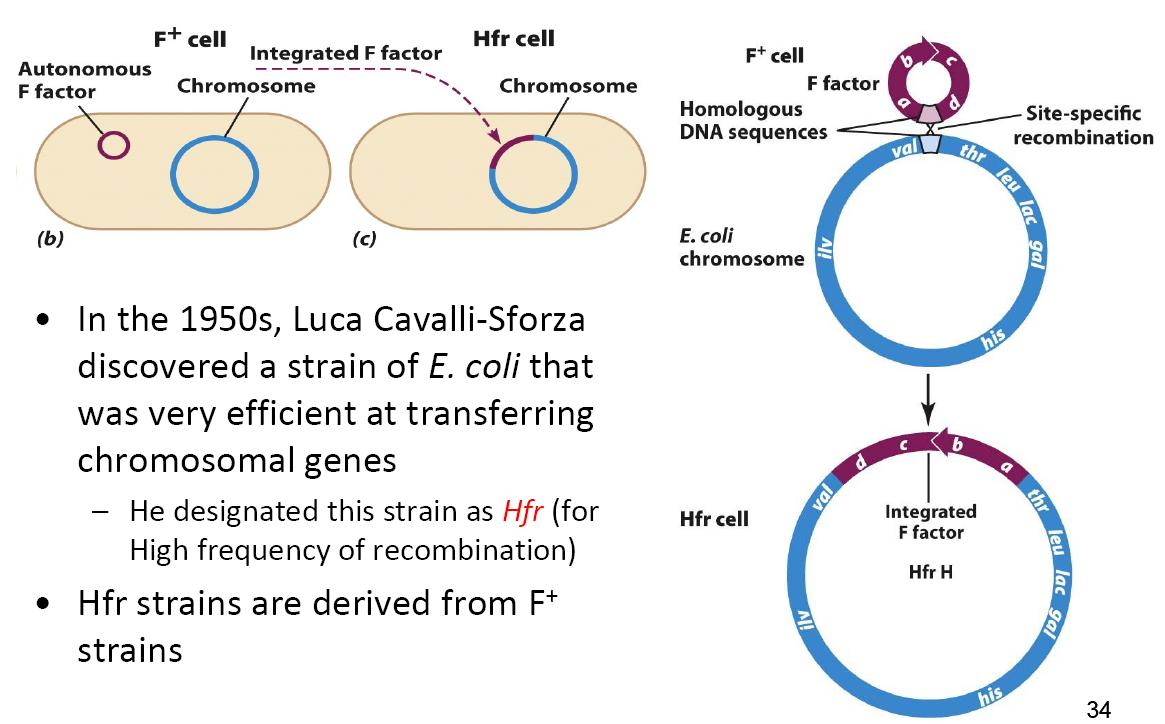
The F factor integrated to different site, then form different kinds of hfr cells
Different integration sites:
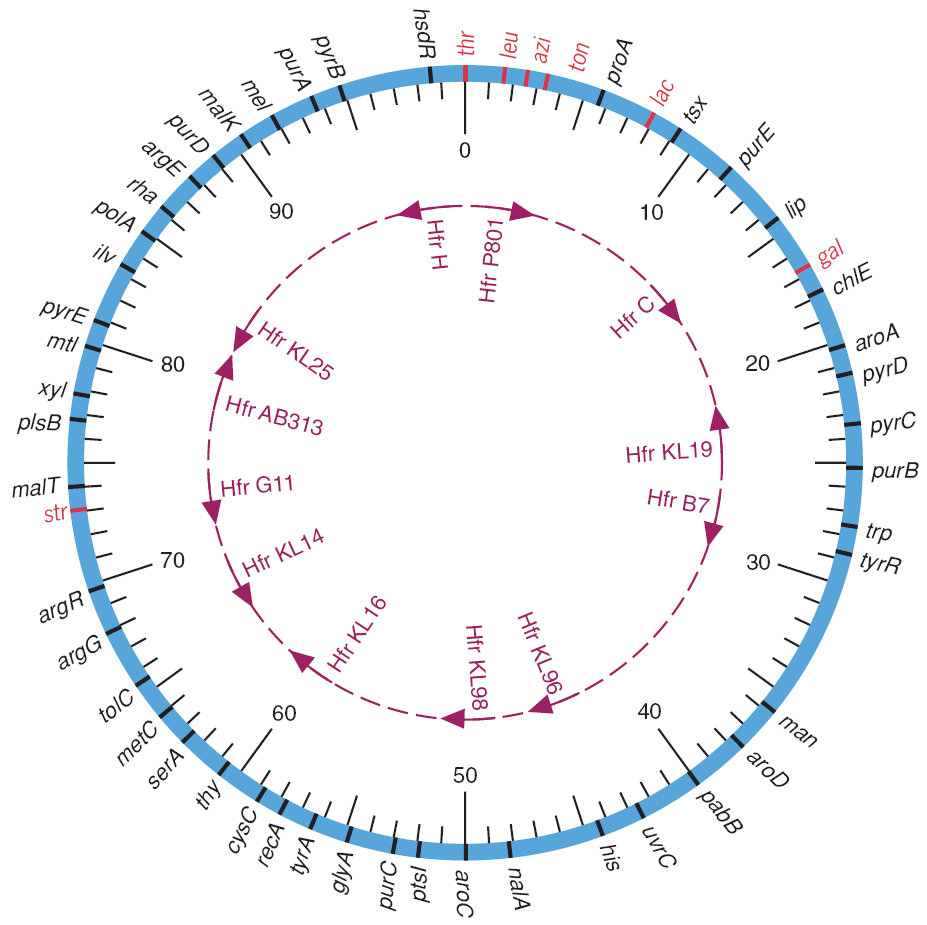
Formation of F’ factor
In some cases, the integrated F factor is excised in an imprecise fashion
- may carry genes that were once found on the bacterial chromosome
- These types of F factors are called F’ factors
F‘ factors can be transferred through conjugation
This may introduce new genes into the recipient cell and thereby alter its genotype
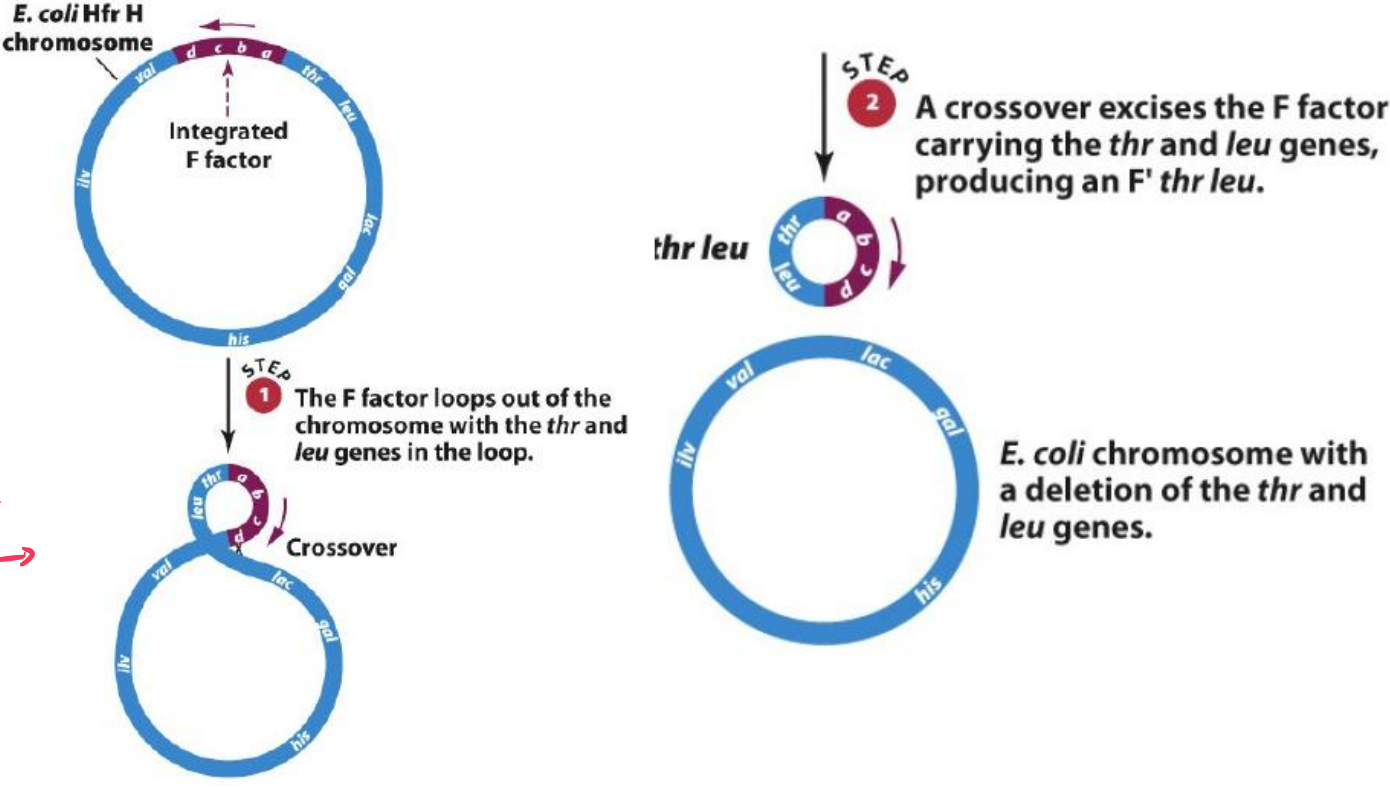
Excise part of the original gene – form F’ Factor
Conjugation between Hfr cell and $F^{‐}$ cell
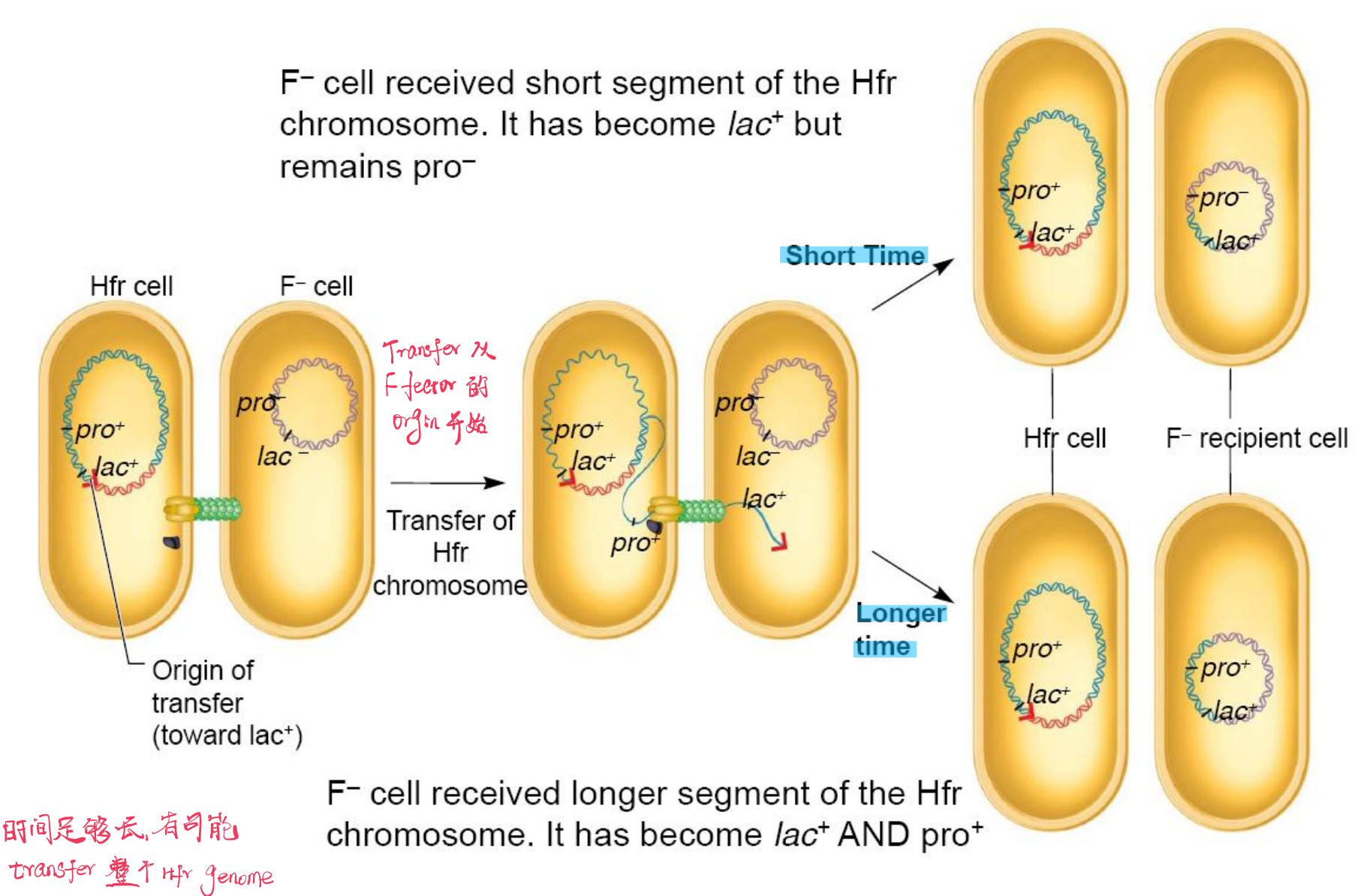
Transfer 从 F Factor 的 Origin 开始,并且如果时间足够长,有可能将整个Hfr Genome转移过去
Entire Hfr chromosome can be transferred in about 90 – 120 minutes but most matings do not last that long
- Only a portion of the Hfr chromosome gets into the $ F^{-}$ cell
- Since the nick is internal to the integrated F factor; only part of the F factor is transferred
The $ F^{-}$ cell receives chromosomal DNA
- This DNA can recombine with the homologous region on the chromosome of the recipient cell
- May provide the recipient cell with new alleles
(1) Interrupted Mating to Map Order of Genes along E. coli Chromosome
Developed by Elie Wollman and Frangois Jacob in the 1950s
The order of genes along the chromosome can be deduced by determining how long it takes for the genes to be transferred during an Hfr mating
- Interrupting mating at different times would result in recipient cells receiving different lengths of DNA
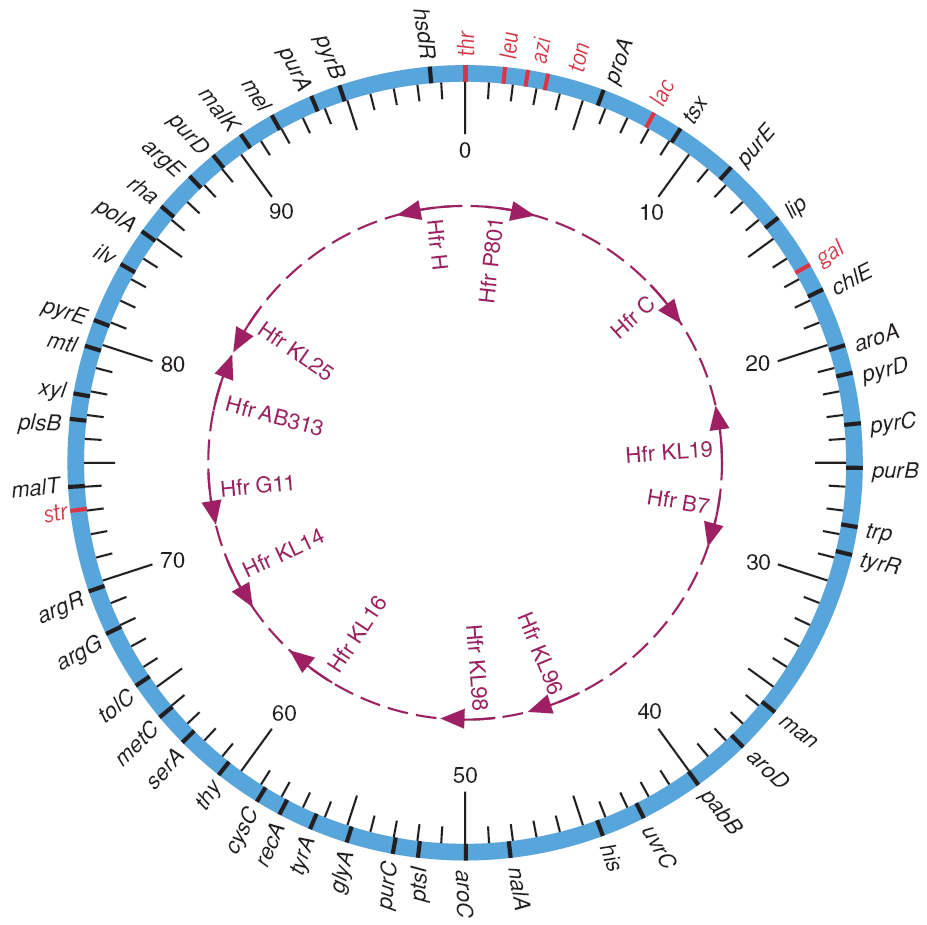
The donor (Hfr) strain had the following genetic composition
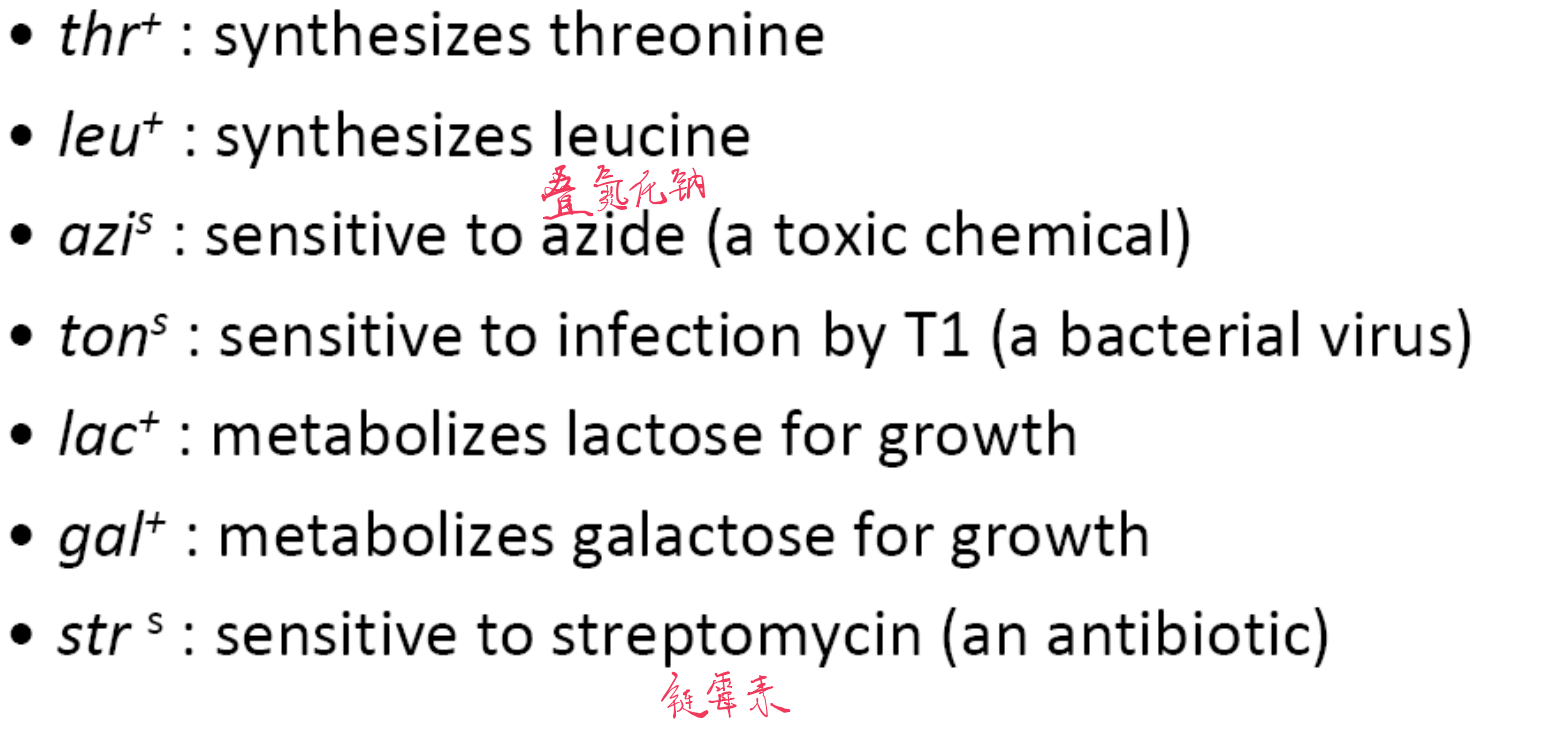
The recipient ($ F^{-}$) strain had the opposite genotype

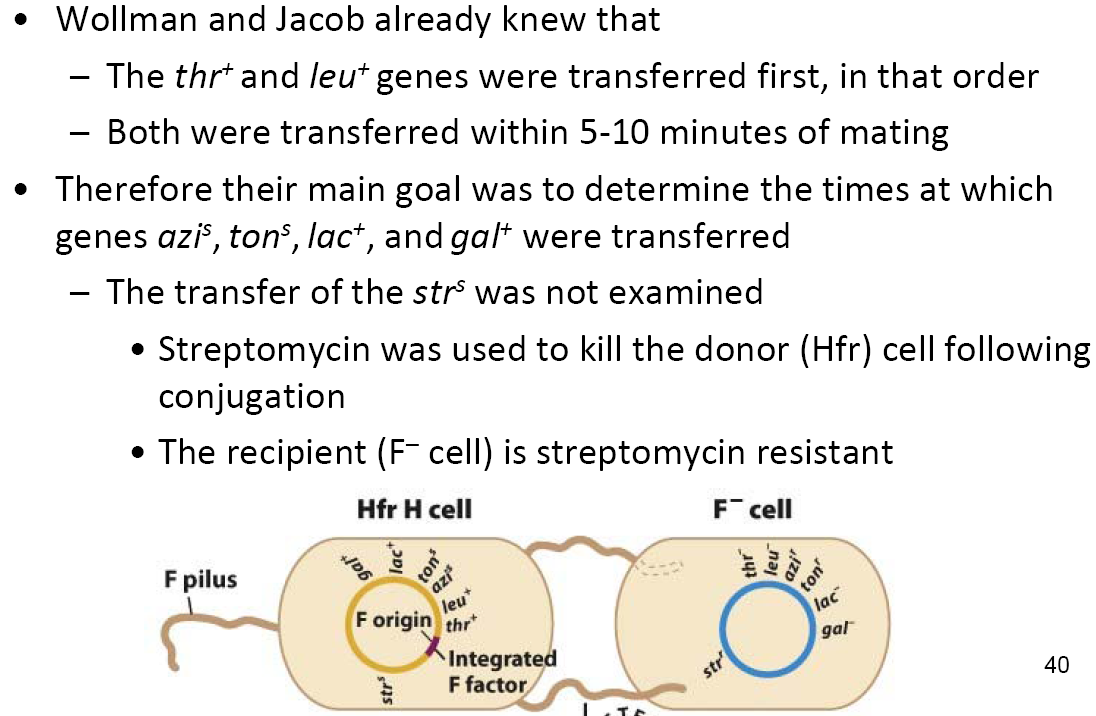
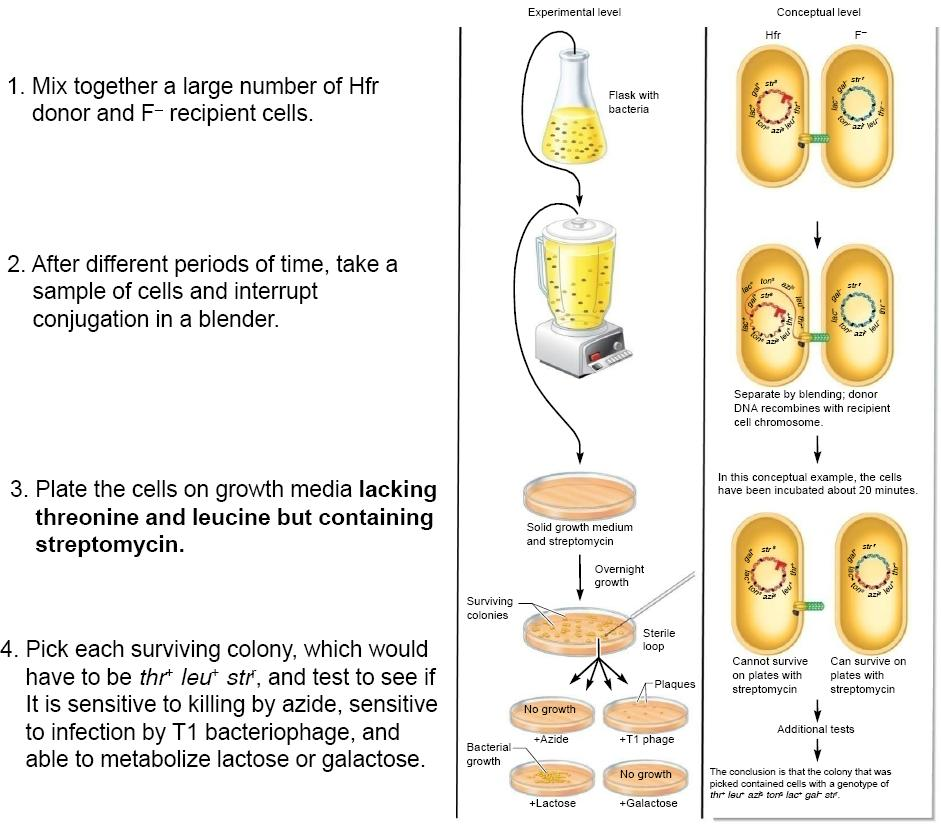
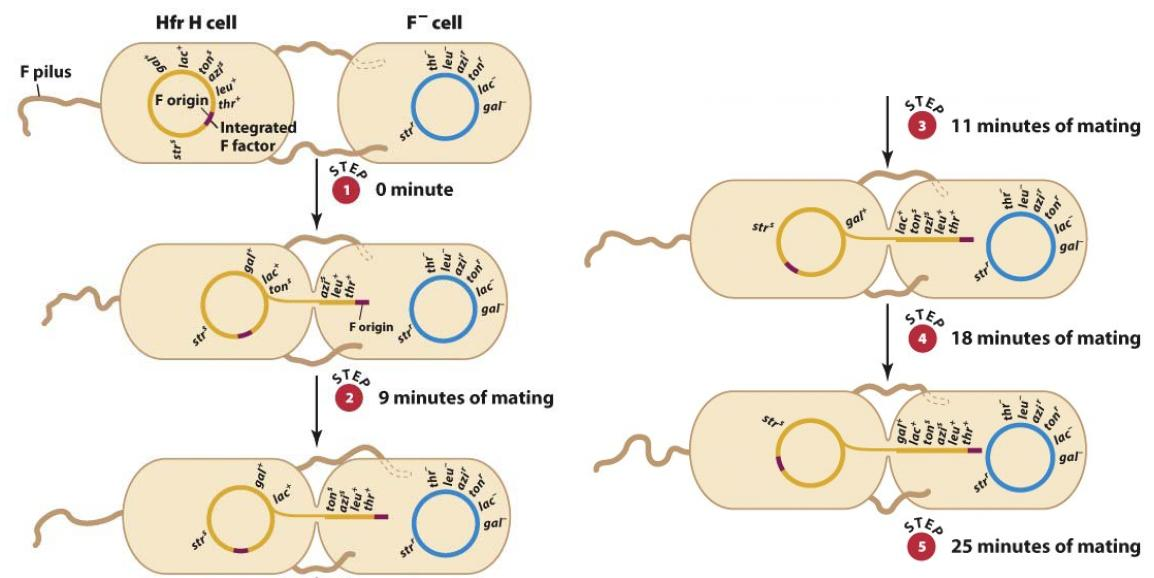
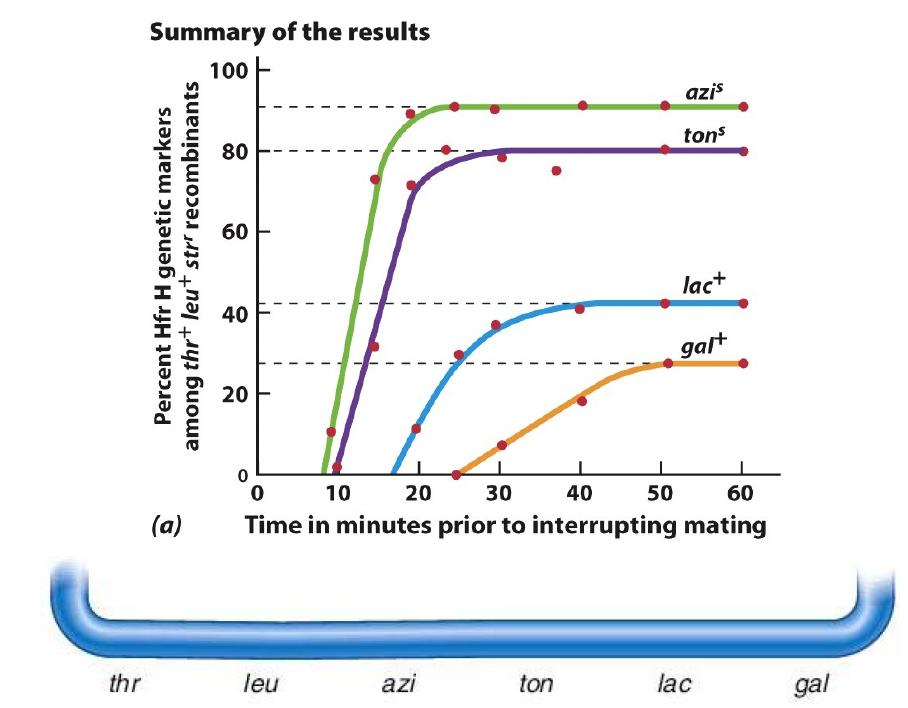
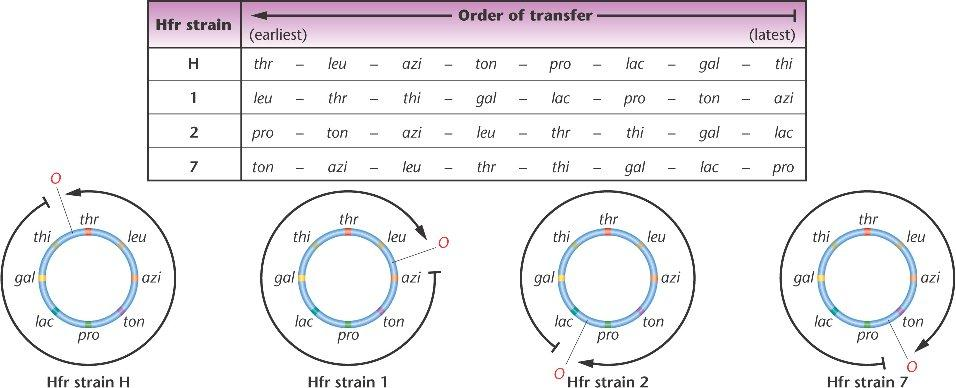

5. Transduction
In transduction, a bacteriophage transfers DNA from a donor cell to a recipient cell.
In generalized transduction, a random fragment of bacterial DNA is packaged in the phage head in place of the
phage DNA.
In Specialized transduction, only particular bacterial genes are transferred to recipient cells
- Viral DNA integrates into the bacterial chromosome a specific site
- When viral DNA is excised, it picks up a piece of chromosomal DNA by accident
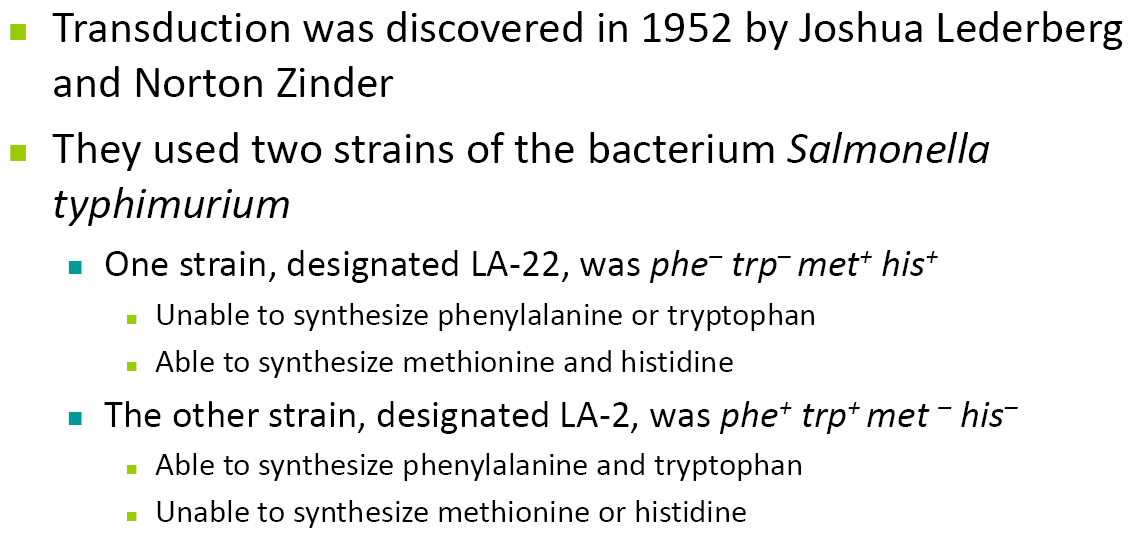
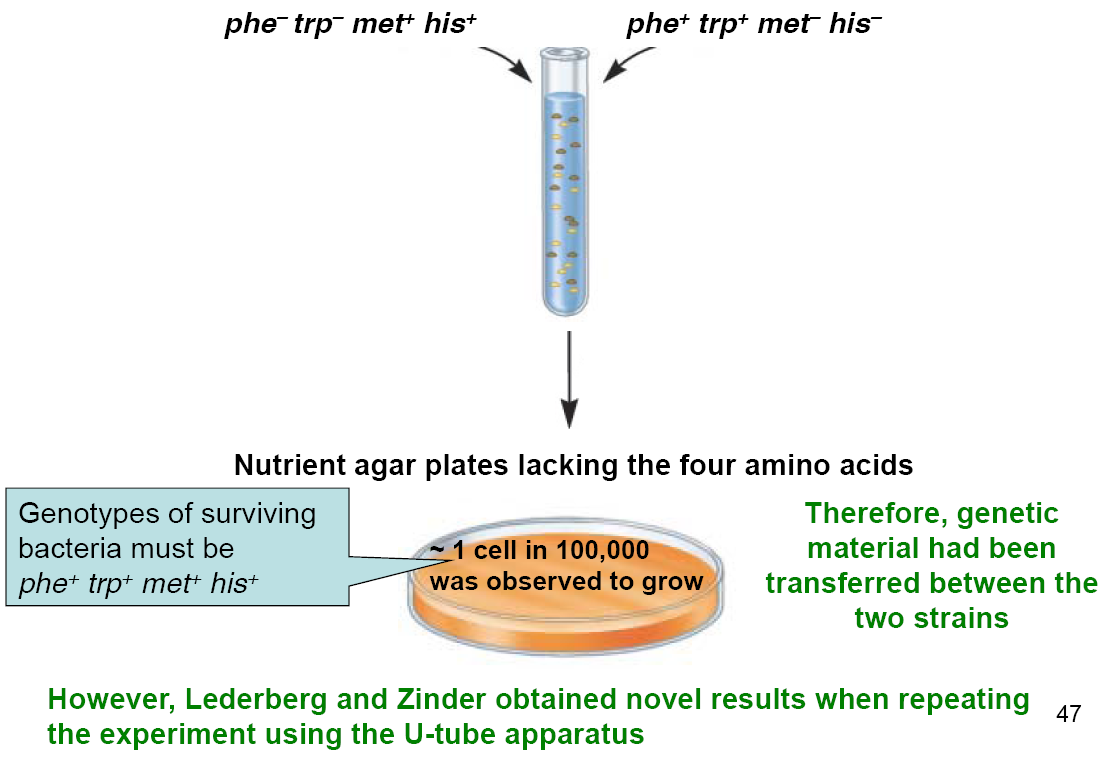
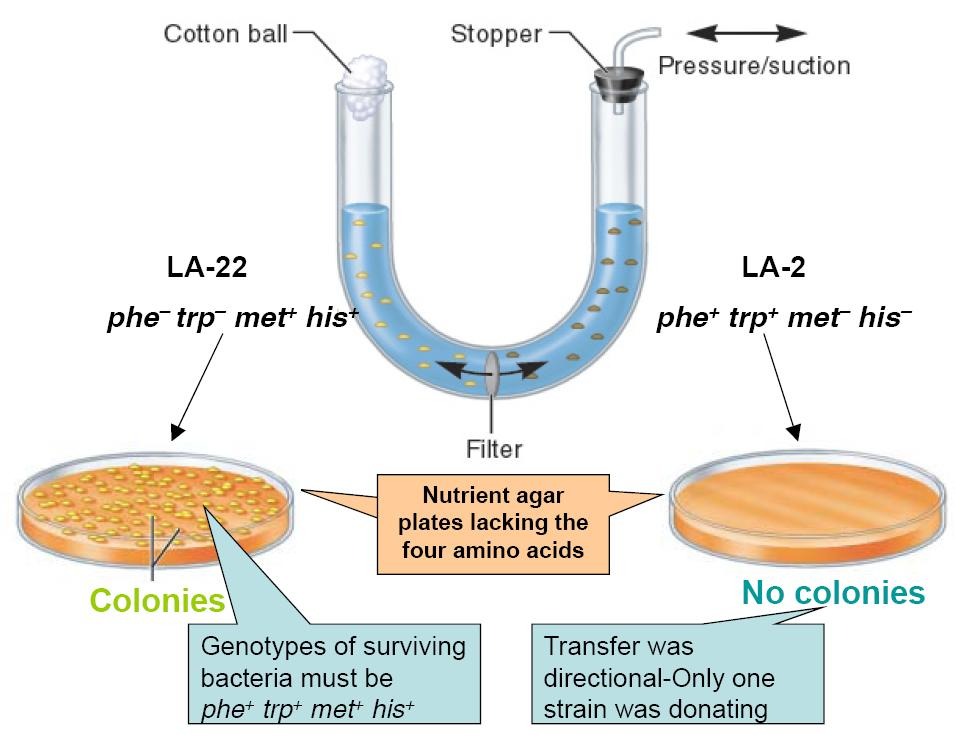
Therefore, some agent was being transferred from LA-2 to LA-22 through the filter
Norton and Zinder conducted the same experiment with filters of different pore sizes
- They found out that the filterable agent was less then 0.1mm in diameter and insensitive to DNase
- They correctly concluded that the filterable agent was a bacteriophage
(1) Generalized Transduction 普遍性转导;普通性传导
Phages that can transfer bacterial DNA include
- P22, which infects Salmonella typhimurium
- Pl, which infects Escherichia coli
(2) Specialized Transduction 局限性转导; 特异性转导
Phage λ
